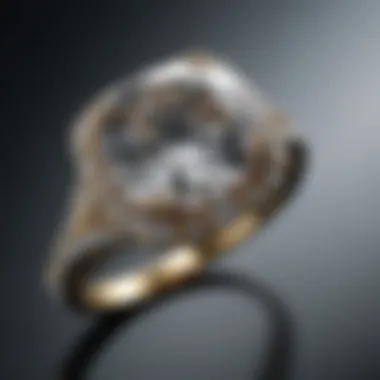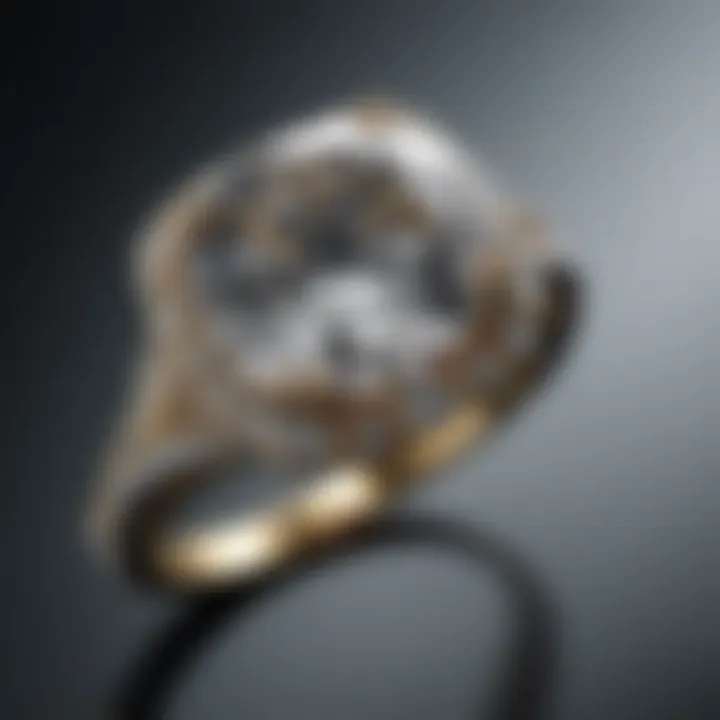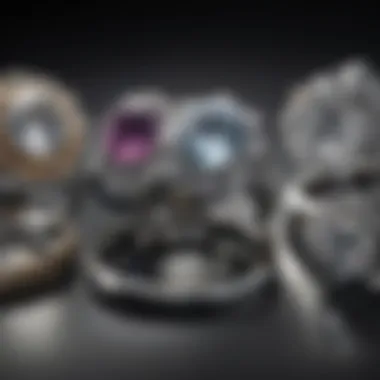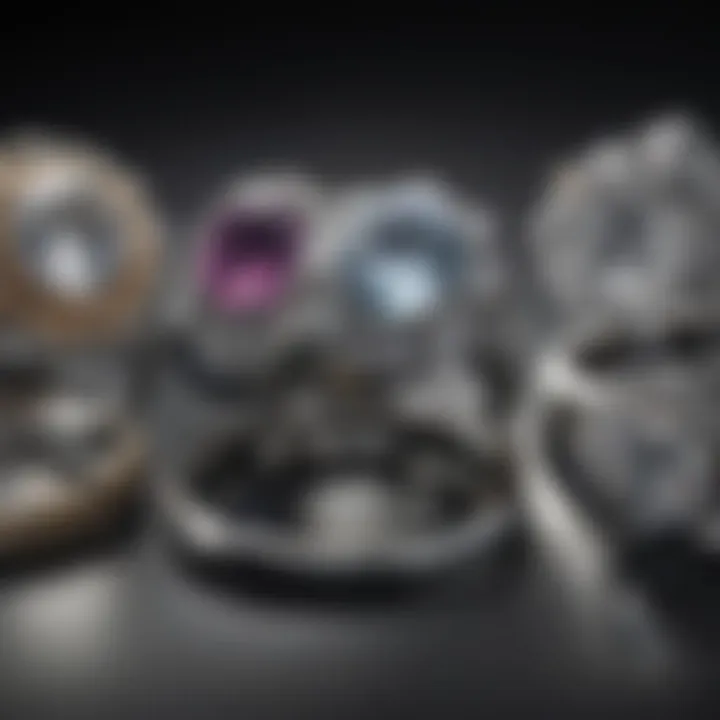How to Determine Engagement Ring Costs Effectively


Intro
When contemplating the purchase of an engagement ring, many individuals confront multifaceted deliberations. The decision encompasses more than just a monetary figure; it involves understanding the underlying factors that contribute to the overall cost. Prospective buyers often find themselves navigating societal expectations, personal budgets, and the evolving market trends within the jewelry industry. Understanding these elements can provide a clearer pathway in deciding how much to invest in an engagement ring. This guide aims to dissect these concerns, offering insights that aid in making informed decisions about this meaningful purchase.
Gemstone Overview
Definition of Gemstones
Gemstones are precious or semi-precious stones that are typically used in jewelry. They are valued for their beauty and rarity, and they also provide a canvas for expressing personal taste and preferences. The characteristics that define gemstones include clarity, cut, color, and carat weight, often referred to collectively as the "Four Cs." The interplay of these attributes greatly affects the quality and price of the gemstone, making them a crucial factor in the overall cost of an engagement ring.
Classification of Gemstones
Gemstones can be broadly classified into two categories: natural and synthetic.
- Natural Gemstones: These stones are formed naturally over millions of years, often involving geological processes in which mineral crystals crystallize. Diamonds, sapphires, and emeralds are prime examples.
- Synthetic Gemstones: These are created in laboratories using technological methods that mimic natural processes. They possess similar chemical and physical properties but often come at a lower price, offering a budget-friendly option for many.
Understanding the distinctions between these classifications is essential for buyers wishing to make informed decisions regarding the cost and value of their chosen engagement ring.
Historical Significance
Origins of Gemstone Use
The use of gemstones dates back thousands of years and has roots in both decorative and symbolic applications. People have adorned themselves with stones for both aesthetic appeal and as symbols of wealth and status throughout history. Certain gemstones were believed to hold magical properties, often used to signify love, fidelity, and commitment. The shift from casual adornment to the deeper societal significance of gemstones occurred particularly during the Middle Ages.
Cultural Insights: Gemstones in Ancient Civilizations
Various ancient civilizations attributed significant importance to gemstones. For instance, in ancient Egypt, gemstones were used not only as jewelry but also in burial practices. They believed that certain stones could provide protection or an afterlife advantage. Similarly, the Romans and Greeks revered certain gemstones, employing them to signify power and divine favor.
Gemstones have transcended their physical beauty, representing social values, beliefs, and cultural heritage throughout the ages.
Understanding the historical context of gemstones enriches one's appreciation of their value. Awareness of this backdrop can influence decisions on what to choose, often leading buyers to select stones that resonate with them personally while considering their historical significance.
Understanding Engagement Ring Pricing
Engagement ring pricing is a complex issue that draws on various elements, including cultural expectations, historical context, and personal financial capability. For anyone looking to make a significant purchase, understanding these factors is essential. This section lays the groundwork for a comprehensive discussion on how to navigate the often bewildering world of pricing engagement rings.
The importance of grasping engagement ring pricing cannot be overstated. It influences not just the selection of the ring but also informs the buyer’s emotional journey. The ring symbolizes commitment, thus its cost should reflect both the buyer's priorities and the recipient's expectations.
This comprehensive review will take into account the historical shifts in pricing, the implications of societal norms in modern engagements, and the financial implications involved in ring purchases.
Historical Context
Historically, the practice of giving engagement rings dated back centuries, evolving through various cultures and timelines. The concept began as a mere form of contractual agreement, but it has since morphed into a romantic symbol of commitment. The ancient Romans are sometimes credited with the origin of engagement rings, where brides received them as tokens of ownership. This association with ownership has faded over time, replaced by emotional significance and the desire to choose something that resonates personally with partners.
In the 20th century, the marketing efforts of diamond companies revolutionized how engagement rings are perceived. The phrase ‘A Diamond is Forever’ popularized the notion that diamonds symbolize eternal love, thereby shifting consumer expectations significantly. Over the decades, this has led to the modern rituals surrounding the purchase of engagement rings. Its cost became intertwined with societal norms, subsequently affecting the decisions of buyers worldwide.
Modern Norms and Expectations
Today, engagement rings are often steeped in personal meaning, but they also come with societal pressures that influence pricing. The prevalent narrative often leads purchasers to believe that a hefty price tag signifies the depth of love and commitment, which may not hold true for all couples. Pricing expectations can also differ based on geographic locations, cultural backgrounds, and individual preferences.
Many contemporary buyers face the challenge of balancing these expectations with their financial realities. The choices are abundant, but the expectations can become overwhelming. Factors such as the type of stone, ring design, and brand reputation often serve as significant determinants of cost.
Consequently, modern norms compel buyers to consider not only what they feel is necessary for a lasting symbol of love but also the pressure from friends, family, and societal standards. This paradox makes understanding the landscape of engagement ring pricing critical for achieving a balanced perspective on what should be invested in such a personal purchase.
The Traditional Three-Month Salary Rule
The Traditional Three-Month Salary Rule serves as a common benchmark in determining how much should be spent on an engagement ring. Historically accepted, this guideline suggests that one should allocate an amount equivalent to three months of their salary for the purchase of an engagement ring. This rule's significance lies in its established nature and how it frames discussions about budget and expectations when buying a ring.
Origins and Popularity


The origins of the Three-Month Salary Rule can be traced back to the marketing efforts of the diamond industry in the early 20th century. Notably, in the 1930s, De Beers launched a campaign promoting diamonds as the ultimate symbol of love and commitment. They suggested that spending a month's salary would be less prestigious, thereby pushing the narrative towards three months. Over time, this marketing succeeded in embedding itself into societal expectations regarding engagement rings. As a result, many people began to view this figure as a reasonable and expected expenditure. The rule gained traction, becoming a cultural norm that influences how couples approach the purchase of engagement rings even today.
Despite its popularity, it is crucial to understand that not everyone adheres to this standard. Various socio-economic factors, personal beliefs, and regional customs can influence individuals' interpretations of this rule, leading to a wide range of spending behaviors across different groups.
Limitations of the Rule
While the Three-Month Salary Rule provides a clear reference point, it also comes with significant limitations that potential buyers should carefully consider. Firstly, this guideline does not consider personal financial circumstances. Someone's salary may vary greatly, and suggesting a fixed spending limit disregards other financial obligations. This may lead to the individual accruing debt or straining their finances unnecessarily in pursuit of an arbitrary benchmark.
Additionally, the rule is somewhat dated in modern contexts. As societal norms shift, couples today often emphasize personalization and meaningful choices over strict adherence to traditional benchmarks. Studies have shown that people are more inclined to focus on emotional significance rather than a predetermined monetary value.
Furthermore, in an era where alternatives like lab-created gemstones provide various options at diverse price points, the strict guideline can stifle creativity in choosing a ring that reflects the couple's personal style. Ultimately, while the Three-Month Salary Rule serves as a useful starting point for budgeting, it should not be seen as a definitive measure for spending. Couples are encouraged to base their decisions on personal circumstances, values, and preferences, aiming for significance rather than simple compliance with tradition.
Factors Influencing Cost
In the intricate world of engagement rings, determining a suitable cost involves careful examination of various factors. This section elaborates on the essential elements influencing the overall pricing of engagement rings, from the gemstone to the craftsmanship. Understanding these factors is crucial for prospective buyers aiming to achieve both personal satisfaction and financial prudence.
Type of Gemstone
Diamonds
Diamonds remain the most sought-after gemstones for engagement rings. Their brilliance and hardness make them an enduring favorite. A diamond's value is principally determined by the four Cs: cut, color, clarity, and carat weight. The more exceptional these characteristics, the higher the price. Diamonds are traditionally viewed as indicators of luxury and commitment. Their unique characteristics often symbolize eternal love, making them a prominent choice for couples. However, the cost of diamonds can be considerable, demanding careful budgeting and consideration.
Alternative Gemstones
Alternative gemstones, such as sapphires, emeralds, or moissanite, offer unique allure at often lower prices. These stones can provide stunning aesthetics and individual character. For many, choosing an alternative translates to a budget-friendly yet equally meaningful option. Moreover, the variety available allows couples to select a stone that resonates personally. However, they may lack the universal recognition and status that diamonds possess, which can be significant for some buyers.
Synthetic vs. Natural
The debate between synthetic and natural gemstones is ongoing. Synthetic gemstones, like lab-created diamonds, provide the same physical and chemical properties as natural counterparts but at a lower cost. These options cater to eco-conscious buyers and those wary about the ethical implications surrounding gemstone mining. Natural gems, on the other hand, can carry a historical essence and rarity, which some people find invaluable. Understanding each type's advantages helps buyers make informed decisions reflecting both personal values and budget considerations.
Setting and Design
Classic vs. Contemporary
The setting and design of an engagement ring influence its aesthetics and cost significantly. Classic designs tend to feature solitaires or simple bands, often favoring elegance over elaboration. These types are usually more affordable due to their straightforward construction. Contemporary designs, however, embrace unique elements and intricate settings. Such designs can enhance visual appeal and overall stone visibility but often come with increased costs. This choice should consider not only personal taste but also long-term preferences regarding style and trends.
Customization Options
Customization allows couples to create a ring that reflects their unique story. This process can range from selecting specific stones to creating entirely bespoke settings. While customization can elevate the overall cost, it brings unparalleled personal significance to the engagement ring. Buyers must weigh the investment against emotional value while considering whether the bespoke features truly resonate with their individual relationship.
Metal Choice
Gold
Gold remains a classic metal choice for engagement rings. It comes in various colors—white, yellow, and rose—each offering distinct appeal. Gold’s versatile nature allows it to complement almost any gemstone. Its adaptability makes it popular, yet the price can fluctuate based on purity and market demand. One disadvantage to gold can be its susceptibility to scratches, potentially affecting long-term durability.
Platinum
Platinum is treasured for its durability and naturally white hue. It is denser than gold, making it more resistant to damage and wear. Many buyers appreciate its hypoallergenic properties, suitable for sensitive skin. However, platinum comes at a mid-to-high price range due to its rarity. This high cost often reflects its quality and enduring nature, justifying the investment for some.
Palladium
Palladium is an alternative to platinum that shares many similar qualities, like being lightweight and hypoallergenic. It is less expensive, making it an attractive option for those who want platinum-like benefits without the price tag. However, palladium may not be as readily available, and some may perceive it as less prestigious compared to platinum or gold. This trade-off should be considered when selecting a metal for an engagement ring.
Craftsmanship and Brand Reputation
The craftsmanship of a ring often reflects not only in its beauty but also its price. Jewelers with established reputations tend to charge premium prices due to their experience, quality assurance, and brand value. Higher-end craftsmanship often ensures that the design is meticulously executed. Opting for a lesser-known brand may offer cost savings but could involve risks regarding quality and support post-purchase. Ultimately, the choice must balance aesthetics, personal preference, and an assessment of what defines quality in the ring's construction.
Personal Budgetary Considerations


Understanding personal budgetary considerations is essential when selecting an engagement ring. This topic helps prospective buyers frame their options. It emphasizes that financial realities can be just as important as emotional sentiments. Saving for the future is often a priority. Balancing budget with quality ensures that the decision made is prudent and fulfilling.
Assessing Financial Readiness
Assessing financial readiness starts with a clear evaluation of one’s financial situation. This involves reviewing income, savings, and any existing debts. Understanding how much money can be set aside for an engagement ring is key. An online calculator can assist in estimating affordability. It is important to avoid the trap of overspending. This will lead to stress later on.
Some factors to consider include:
- Existing Savings: Current savings might determine the initial amount allocated.
- Monthly Expenses: Assessing monthly outgoings can help understand how much extra can be redirected toward purchasing the ring.
- Future Financial Goals: Consideration of future plans, such as buying a house, can influence the ring budget.
It may be helpful to set aside funds over a certain period. A savings plan can facilitate better financial preparedness. Individuals should aim to be honest about what is achievable.
Setting a Realistic Maximum
Setting a realistic maximum budget is a crucial step. This requires disciplined thought about what is feasible. It can be easy to be swayed by expectations or wants. However, creating a cap fosters smarter decisions. This cap should not only include the price of the ring but potential additional costs, such as insurance.
Buyers can consider:
- Market Prices: Researching average engagement ring prices can provide benchmark figures.
- Personal Limits: Reflect on personal values regarding spending. It is vital to remain true to financial capabilities.
- Willingness to Compromise: Identify features that can be sacrificed, like carats or setting, to fit the budget.
Having a defined maximum budget allows for a more focused search, reducing unnecessary stress during the purchasing process.
In summary, aligning personal finances with the engagement ring goals helps mitigate pressures and enhances the overall experience of the ring-buying journey. With clarity and purpose, buyers can navigate their options effectively.
Exploring Alternatives
Exploring alternatives when considering the cost of an engagement ring is a significant step. Many prospective buyers are unaware that options exist beyond traditional choices. These alternatives can provide both savings and unique appeal while maintaining the emotional weight that engagement rings symbolize.
Lab-Created Gemstones
Lab-created gemstones have emerged as a strong alternative to mined stones. They possess identical physical, chemical, and optical properties but are often less expensive. This makes them appealing to buyers who want a high-quality gem without the associated costs of natural stones. Moreover, lab-created gemstones are produced under controlled conditions, making their sourcing more ethical compared to conventional mining methods.
These gems offer a sustainable choice as well, reducing the environmental impact associated with traditional gemstone extraction. Popular varieties, such as lab-created diamonds, sapphires, and rubies, are increasingly gaining recognition. Consumers can enjoy the beauty of these stones without compromising on their values, which is a significant consideration in today's market.
Vintage and Pre-Owned Options
Vintage or pre-owned engagement rings represent another viable option for budget-conscious buyers. These rings often carry a history, making them unique choices that reflect individuality. Many vintage styles can’t be replicated, and this nostalgia can add emotional value for the wearer.
Choosing a pre-owned ring can be economically wise. Generally, they cost significantly less than new rings, allowing buyers to acquire higher-quality pieces for the same budget. Additionally, vintage rings often feature craftsmanship that is hard to find in modern pieces, appealing to collectors and enthusiasts genuinely.
However, examining the condition of these rings is crucial. Ensuring the integrity of the setting and stones should be a priority.
Synthetic Diamonds
Synthetic diamonds are another alternative worth considering. These are not only more affordable than their natural counterparts, but they also represent a significant step towards responsible sourcing. Synthetic diamonds are created through advanced technology, simulating the conditions under which natural diamonds form.
This process allows for greater control over quality and characteristics, leading to stones that can be more flawless than mined diamonds.
Additionally, just like lab-created gemstones, synthetic diamonds have a reduced environmental footprint. While there may still be some stigma attached to synthetic diamonds, their growing acceptance among consumers indicates a shift in perception towards recognizing their value.
The Role of Insurance
Insurance for an engagement ring serves several crucial functions, making it an essential aspect for anyone considering such a significant purchase. When you invest in an engagement ring, it is more than merely a piece of jewelry; it often holds deep emotional value, representing commitment and love. Thus, protecting this precious item from potential loss or damage is paramount.
Choosing insurance provides financial security. Engagement rings can be costly, often amounting to thousands of dollars. Without protection, a loss could represent a substantial financial hit. Policies ensure that you can replace or repair the ring without incurring insurmountable debts. Furthermore, having insurance offers peace of mind. Knowing that your investment is safeguarded can alleviate anxiety, allowing couples to enjoy their engagement fully.
Why is Insurance Necessary?
The necessity of insurance becomes evident in several scenarios. Loss, theft, or damage can happen unexpectedly, and the emotional turmoil of losing a cherished item can be compounded by the financial implications.


- Loss due to theft: An engagement ring may become an attractive target for thieves. The emotional distress from losing a ring can be profound, and this is coupled with the practical need for restitution.
- Accidental damage: Rings can suffer from scratches, dents, or even stone loss from everyday wear. Insurance can cover repair costs, which might otherwise be significant.
- Retailer warranties may not suffice: Many retailers provide warranties, but they often do not cover theft or loss. Insurance fills this gap, providing comprehensive protection that goes beyond what a retailer may offer.
- Value changes over time: As personal circumstances change—such as moving, traveling, or changes in status—the ring may need to be valued differently. Insurance allows you to revisit your policy regularly, ensuring adequate coverage.
Evaluating Insurance Policies
When assessing insurance policies for your engagement ring, several factors must be considered to ensure that you choose the right coverage. Evaluating the following aspects will help in making an informed choice:
- Coverage Amount: Look at how much the policy will cover. Ideally, it should match or exceed the cost of the ring at the time of purchase. This includes not just the gem but also the setting and any bespoke designs.
- Type of Coverage: Policies may vary significantly. Some include full replacement, while others may only provide a cash settlement or repair. Understanding what exactly is covered is crucial.
- Premium Rates: Consider how much you will be paying annually or semi-annually for the insurance. Make sure this fits within your budget, as higher premiums do not always equate to better coverage.
- Claims Process: Research how claims are handled. A smooth and transparent claims process is essential, ensuring that you are not left frustrated if you do have to file a claim.
- Policy Exclusions: Be well aware of any exclusions in the policy. For example, some policies do not cover loss while traveling or may have specific terms regarding care and maintenance.
By evaluating these factors, you ensure that the insurance for your engagement ring is not only necessary but also adequate to protect your investment effectively.
Impact of Cultural Norms
Cultural norms play a vital role in determining the cost and significance of engagement rings. These norms shape expectations regarding how much to spend, the style of the ring, and even the entire proposal process. Recognizing these influences is crucial for prospective buyers. Understanding cultural variations can guide individuals in making choices that reflect both personal values and societal expectations.
Regional Differences in Ring Traditions
Traditions concerning engagement rings vary significantly across the globe. In some cultures, such as in the United States, a diamond is often seen as the quintessential choice. This originates from marketing campaigns that have shaped societal expectations for decades. In contrast, cultures in South Asia may lean toward gold rings, symbolizing wealth and prosperity.
Moreover, in specific African cultures, the act of giving a ring may involve complex rituals and negotiations between families. Each regional tradition also dictates how rings are presented or received. For example, in some cultures, the engagement ring is given after formal engagement ceremonies, while in others, it can be a surprise at a celebratory event.
The influence of local customs also extends to the cost. In regions where gold or colored gemstones are favored, the pricing structure can differ significantly from diamond-centric markets. Buyers must consider these differences to ensure their choice aligns with the cultural significance of the ring.
The Evolution of Proposals
The concept of proposing marriage has evolved over time, influenced by shifting societal norms and cultural practices. Historically, proposals were often transactional, involving families. As society progressed, particularly in Western cultures, the act of proposing became more personal and romantic. However, it retained its cultural significance, with engagement rings serving as symbols of commitment.
In contemporary society, proposals can vary widely. For example, some may involve elaborate events, while others may take place in intimate settings. This shift has also influenced engagement ring costs. In communities where grand gestures are valued, the expectation may lead individuals to spend more to impress.
Understanding the evolution of proposals helps individuals navigate the expectations surrounding engagement rings. It illustrates the balance between respecting cultural traditions and embracing personal preferences.
Cultural norms are not static; they can change over time, reflecting shifting values and beliefs among communities. Keeping this in mind can support informed decisions when selecting an engagement ring.
Negotiating with Jewelers
Negotiating with jewelers is a critical aspect of purchasing an engagement ring that is often overlooked. Understanding how to engage effectively can lead to significant financial benefits and ensure that you receive a product that meets your expectations in terms of quality and aesthetics. This section explores the fundamental elements of negotiation, including markups and customization discounts, equipping readers with strategies to make informed choices.
Understanding Markups
The first step in negotiating with jewelers is to grasp the concept of markups. Jewelers typically add a markup on the cost of materials, labor, and their overhead expenses. This markup can vary widely depending on the retailer. Commonly, it ranges from 30% to 200% above the wholesale price. This means that understanding the actual, intrinsic value of the gemstone and setting can empower buyers when entering negotiations.
- Research is Key: Knowledge of current market prices for specific gemstones, such as diamonds or alternative stones, positions buyers to challenge unfair pricing. Websites like Wikipedia provide useful insights into pricing structures and industry standards.
- Inquire About the Development Process: A good jeweler is transparent about their sources and production processes. Asking for this information not only shows that you are informed but also helps in gauging what is a reasonable markup.
Using such information effectively can enable prospective buyers to request better prices without compromising on quality. Additionally, many jewelers have flexibility within their pricing structures; the key is to initiate that conversation.
Asking for Customization Discounts
Customization can make an engagement ring distinctly personal, yet it often comes with added costs. Engaging the jeweler to inquire about discounts related to customization is valuable. Here are several points to consider:
- Value of Personalization: Custom rings often have more emotional weight. Highlighting this during negotiation may prompt the jeweler to consider offering discounts or inclusive services such as free resizing or additional alterations.
- Loyalty and Referrals: If you are a returning customer, or if you can offer recommendations to friends or family, that loyalty can work in your favor. Mentioning potential referrals can sometimes lead to discounts.
- Bundles and Packages: Some jewelers offer packages that include other services, such as insurance or appraisal. Asking about discounts in the context of bundled purchases can yield advantageous terms.
Engaging actively in these kinds of discussions informs the jeweler of your expectations and budgetary constraints, making them more inclined to accommodate your requests.
Engaging in negotiations does not only focus on price; it encompasses the overall purchasing experience and the emotional value attached to the ring.
By understanding markups and articulating your needs effectively, you can forge a more favorable deal, achieving a balance between quality and cost. This strategic approach to negotiation with jewelers is essential in ensuring that the engagement ring you purchase holds both sentimental and financial significance.
Ending
Understanding the appropriate cost for an engagement ring is essential for buyers who wish to navigate this significant purchase with clarity and confidence. This article has explored various factors that influence pricing, such as personal budgets, societal expectations, craftsmanship, and the overall market landscape. Striking a balance between emotional significance and financial readiness is crucial in making this decision. Buyers can avoid common pitfalls and approach the process informed, ensuring their choice reflects both personal value and quality.
Key Takeaways
- Evaluating Personal Finances: Before making a purchase, individuals should assess their financial readiness and establish a realistic budget. This consideration helps prevent debt and promotes a stress-free buying experience.
- Understanding Market Fluctuations: The jewelry market can be volatile. Awareness of pricing trends, especially for specific gemstones like diamonds or alternative options, allows buyers to make timely decisions.
- Cultural Influences: Cultural norms and traditions can shape expectations. Understanding these nuances can guide buyers toward making choices that align with their personal values and societal influences.
- Negotiation as a Tool: Jewelers may negotiate prices. Knowledge about how pricing works and the significance of craftsmanship can empower buyers to seek better deals.
Making an Informed Decision
It is imperative to recognize that every choice should be personal and reflect the individual tastes and values of the couple. Ultimately, the right engagement ring should not only symbolize commitment but also be a prudent investment. Familiarizing oneself with the key points discussed can grant the buyer considerable confidence in their final decision.



